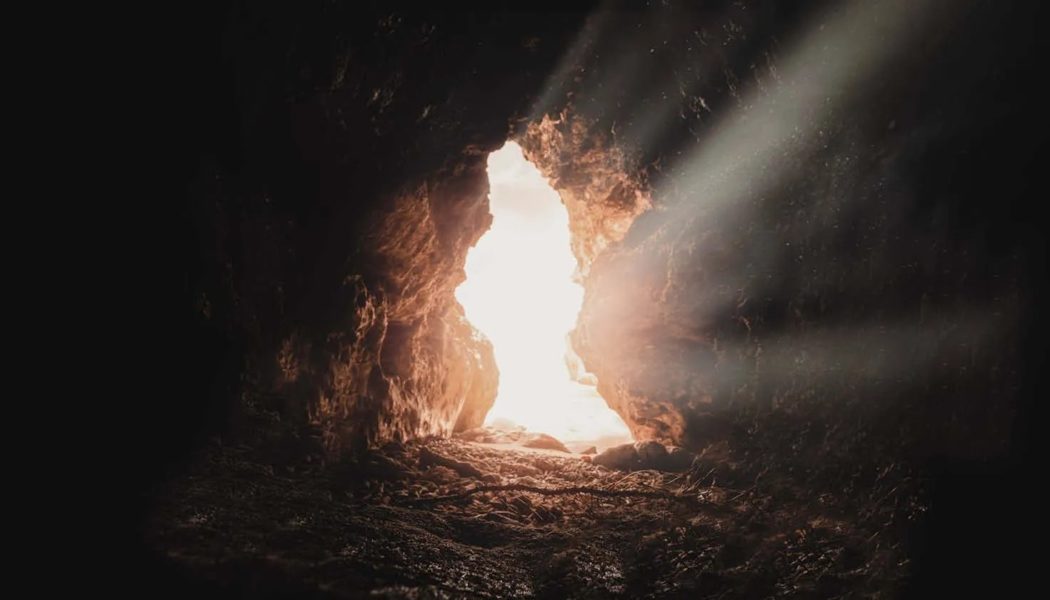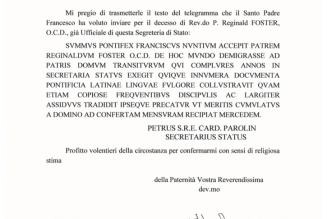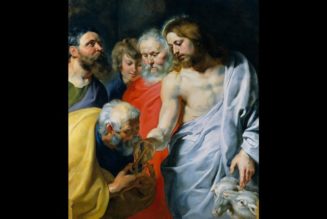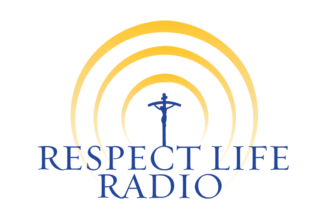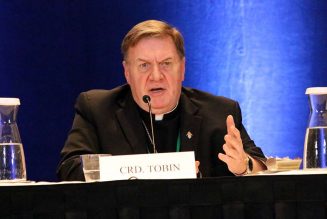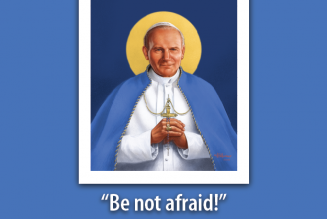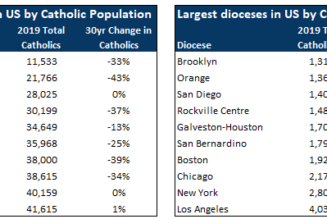
On this Easter Sunday, the Resurrection of the Lord answers a fundamental doubt that has driven many people away from the Church.
The fundamental pieces of the story about Jesus often don’t make sense to us. Why did he have to die? Why did we have to be saved? Why would God create us and then treat us as if we deserve hell, which only the slaughter of his Son could prevent?
Mary Magdalene saw the answer to all of it when she discovered the empty tomb on the first Easter Sunday.
The Gospel says she “came to the tomb early in the morning, while it was still dark.” Doesn’t this describe our encounter with the Christian mystery? We are in the darkness of a harsh world, and we approach Christ timidly, cautiously, skeptically.
What we find is a mystery. Mary Magdalene “saw the stone removed from the tomb.” She runs to Peter, the leader of the Apostles, and John, the “disciple Jesus loved” and tells them, “They have taken the Lord from the tomb, and we don’t know where they put him.”
Again, this is how we feel. Where are all the easy answers we felt we had as children? Where is the Lord we loved? Where are the certainties that used to give us peace?
Peter and John run to the tomb and see Jesus’s burial cloths, a sure sign that the body had not been taken away. The grave clothes had been pasted to Jesus’s body with myrrh. The last thing a graver robber would do would be to struggle to remove burial cloths in a tomb guarded by soldiers and then neatly arrange them in the dark.
Clearly, Jesus had left the tomb in some other way. They “saw and believed,” says the Gospel.
John adds that “they did not yet understand the Scripture that he had to rise from the dead,” because he wants to be clear that he didn’t force the evidence he saw to fit the Resurrection narrative he wanted. Rather, what he saw forced him to believe something new.
From this beginning came the kerygma, the saving message, Peter gives in the First Reading.
St. Peter delivered this message to a world not very different from our own.
The crowds he faced had once been excited about John the Baptist, when “all of Jerusalem and Judea” went out to hear him and be baptized. Later, they had been excited about Jesus the wonder worker, crying out “Hosanna!” as he entered Jerusalem. But the crowds had been disappointed by Jesus. Soon they were shouting “Crucify him!” and then “If you are the son of God come down from the cross!” In the end, they had written him off as a failure and their hopes as embarrassing naivete.
In the same way, this year’s Easter Sunday comes as two things are happening worldwide: A great faith revival and a great apostasy.
It is impossible not to notice the faith resurgence taking place in our time. The faith is booming in Africa and Asia, and our own country is the epicenter of the phenomenon of the Bible in a Year Podcast whose downloads are in the hundreds of millions. YouTube is clocking millions of hours with Bishop Robert Barron and other luminaries sharing the good news that Jesus Christ is the Son of God.
But it is also impossible not to notice the new obstacles to the faith: The horrific counter-witness of the sex abuse coverup, the denial of fundamental truths of the faith by bishops and cardinals, the sophisticated counter-attacks of the new atheists, the rise of the nones — many of whom are former Catholics — and the abandonment of the Church by so many after COVID. We all know people who used to go to Mass but who don’t anymore because the church lockdowns convinced them the sacraments weren’t all that important. We also all know people who were so enraged by the Church’s reaction to COVID, from Pope Francis down to parishes, that they have turned against the Church or left it altogether.
We face people who are hopeful about Christ, disappointed in Christ, angry about Christ, and indifferent to Christ — which is to say, we face exactly what St. Peter faced.
This Easter is an opportunity to return to fundamentals.
The first fundamental is the fact of the Resurrection. Jesus was tortured and killed and then he rose from the dead. The empty tomb changes everything.
Dominion is a 2019 book by Tom Holland — the British historian, not the Marvel actor. After studying ancient cultures in two previous books, he began to realize how much Jesus Christ and his followers reshaped morality worldwide, from the day the stone rolled away from the tomb to right now.
Holland is not himself a practicing Christian, but he understands why the Christian narrative is powerful. “The cross, that ancient implement of torture, remains what it has always been: the fitting symbol of the Christian revolution,” he writes. “It is the audacity of it — the audacity of finding in a twisted and defeated corpse the glory of the creator of the universe — that serves to explain, more surely than anything else, the sheer strangeness of Christianity, and of the civilization to which it gave birth.”
How powerful is the fact of the Resurrection? “It is manifest in the great surge of conversions that has swept Africa and Asia over the past century,” Holland writes, “and, in Europe and North America, in the assumptions of many more millions who would never think to describe themselves as Christian.”
So that’s the first thing to realize: The very fact that Jesus rose from the dead has created a revolution whose reverberations have echoed across time and space for millennia. But it’s also important to see how that works on the individual level.
My friend has a stark way of putting his doubts about Christianity.
“Do you seriously believe God damns people to hell just for being human, and only baptism can save them?” he asks. “How is that loving?”
To answer him, and others like him, we need to translate Peter’s kerygma, his saving message, to the 21st century. Here is how I do it.
To believe the Christian message, in addition to acknowledging the Resurrection, we only have to accept three facts that most of us accept already: Our freedom, our family and our Father.
Take freedom first. It doesn’t take long to see that we are free, and that we use our freedom in ways that harm ourselves and others. Christians believe that this freedom is so real, we can truly love — choosing the good of another over ourselves. And we also believe this freedom is so real, we can really sin — truly rejecting what is right and choosing what is evil.
I absolutely know that people are beautiful, kind and loving — but I can’t help but notice that they are also mean, self-centered, dishonest, and cruel. They don’t just mess up, they choose what is wrong when they could have chosen what is right. Today alone, I have entertained 100 demeaning thoughts, done a dozen things I shouldn’t have done, and said a number of hurtful things I regret.
So, we freely choose to sin.
Look at our families next. Our families determined what we look like, sound like, and act like. They genetically gave us our traits and predispositions, and then by raising us the way they raised us, they made those traits stick. The older I get, the more astounded I am that I am just like my parents, and the older my children get, the more astounded I am that they are just like me. My parents would have said the same thing about their parents, and my grandparents would have said the same thing about my great grandparents, and so on, such that I could trace many family traits all the way back to my earliest ancestors.
Is it fair that I am the way I am because of generations of choices that preceded me? It is not. Does that change the fact that it is true? It does not.
Well, like all the other traits, says St. Paul, “sin came into the world through one man and death through sin, and so death spread to all men because all men sinned.” The Catechism describes how, but G.K. Chesterton called original sin “the only part of Christian theology which can really be proved” because we “can see in the street.” Whether we like it our not, we got our disposition to misuse our freedom along with everything else about us, from our family line, going back ages.
But God is our Father, now and always. In addition to forgetting that we use our freedom to sin, and that our family passes on original sin, we also forget who God is. God isn’t a tyrannical being who exists apart from the world, watching and waiting for us to die so that he can hurl us into a lake of fire. Nor is he a cosmic uncle who shrugs off our evil as if nothing mattered.
He is the ground of all being. He is right here, right now, with us in his presence, essence and power. He is holding together the seat you are resting on, keeping you in your place with gravity, and filling the universe with his light and order.
That means he is also your good Father: His providence gave you the food and water that kept you alive to this moment; his coherence makes it possible for you to see, remember, and understand these words; and his radiant smile is visible in the beauty all around you that makes it possible for you to enjoy what you experience.
He isn’t the God of a long time ago, when the world began. He isn’t the God of years from now, when you will die. He is the God of every time and every place and every person. Nobody now exists or has ever existed outside his power, presence, and essence. He saved the Good Thief on the cross because he was dying right next to him. Well, he is right next to every person dying in every place and every time in the past, present and future. He can, and does, save who he wants, how he wants, when he wants.
And how he wants to draw close to save people right now is in the sacraments of the Church, where we freely join his family, in the the Father, Son and Holy Spirit.
This is what Mary Magdalene, Peter, John, and each of us finds in the empty tomb.
Mary Magdalene knew she had to be saved. She was a sinner who had been possessed by the devil. When she saw the empty tomb, she saw her way out.
Peter knew he had to be saved. He had betrayed his beloved Jesus at his hour of greatest need to save face with a servant girl. The empty tomb gave him a second chance to do right by the Lord.
John knew he had to be saved, also. He was one of the “sons of thunder” who tried to get special treatment from Jesus, and who wanted Jesus to destroy those who rejected him. There at the side of Peter and Mary Magdalene, he saw that Jesus wanted to do the very opposite.
Together, they formed a new family, the family of God, the Church, with Peter at its head, the contemplative John assisting, and Mary Magdalene and a train of sinners, including me, in their wake. We are adopted sons and daughters of the Father, brothers and sisters in Jesus, driven by the Holy Spirit as the whole world shifts on its axis to make way for the newly risen Lord.
Join Our Telegram Group : Salvation & Prosperity
